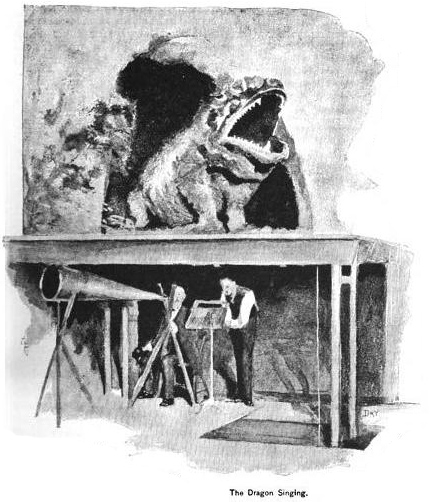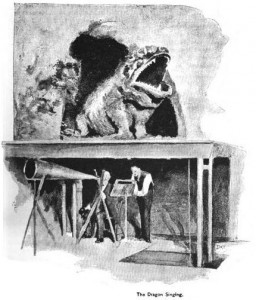Who hasn’t dreamt of running away and joining the circus? Charles Mayer actually did it. In his book, Trapping wild animals in Malay jungles, published in 1922, Mayer talks about his early years when he was a property-boy with a touring big-top show.
I was nearly seventeen when Sells Brothers’ Circus came to Binghamton, New York, where I was living with my parents. That day I joined some other boys in playing hookey from school, and we earned our passes by carrying water for the animals. It wasn’t my first circus, but it was the first time that I had ever worked around the animals and I was fascinated. I didn’t miss the big show, but all the rest of the day I was in the menagerie, listening to the yarns of the keepers and doing as much of their work as they would allow. That night, when the circus left town, I stowed away in a wagon.
The next morning, in Elmira, I showed up at the menagerie bright and early. The men laughed when they saw me. I had expected them to be surprised and I was afraid that they might send me away, but I found out later that it was quite an ordinary thing for boys to run away from home and join the circus. And the men didn’t mind because the boys were always glad to do their work for them. I worked hard and, in return, the men saw that I had something to eat. That night I stowed away again in the wagon.
In Buffalo I was told to see the boss—the head property-man—and I went, trembling for fear he was going to send me back home. Instead, he told me that I might have the job of property-boy, which would give me $25 a month, my meals and a place to sleep—if I could find one. There were no sleeping accommodations for the canvas and property crews; we rolled up in the most comfortable places we could find, and we were always so dead tired that we didn’t care much where we slept.
$25 a month and no place to sleep. This is around 1880, still over a decade from the founding of the National Alliance of Theatrical Stage Employes. By 1896, the rates for traveling men were $20 a week for Assistant Propertymen.
Since those early days in the circus, I’ve been around the world many times, and I’ve seen all sorts of men, living and working in all sorts of conditions, but I’ve never found a harder life than that of property-boy, unless, perhaps, it’s that of a Malay prisoner. Sometimes I wonder how I stood it and why I liked it. But I did stand it and, what is more, I loved it so much that I persuaded the boss to keep me on when we went into winter quarters.
The moment we arrived at a town, the head canvas-man rode to the lot on which we were to show and laid it out; that is, he measured it and decided on the location of the tents. The men with him drove small stakes to indicate where the tentpegs were to be placed. In the meantime, the property gang unloaded the show. Then we drove the four-foot stakes for the dressing-tent into whatever kind of ground the lot happened to have. A man can work up a good appetite by swinging a fourteen-pound hammer for an hour or so before breakfast, but before we started we had also many other things to do. The dressing-tent had to be spread and hoisted; then the properties were sorted and placed in their position for the performers to get ready for the parade. Meanwhile the canvas-gang was getting the “big-top” up. Then, when the parade started, we went to the “big-top” and arranged the properties there, made the rings, adjusted the guys, ropes and wires for the aerial acts and laid out all the paraphernalia for the ground acts. While we were doing these things, the canvas-men were stringing the seats. Then we had breakfast.
When the parade returned, there were cages to be placed in the menagerie tent and the parade properties to be prepared for shipping. By the time that work was finished, the crowds had arrived for the show and we stood by to handle the tackle of the various acts. At night, after the show had started, we began taking down the smaller tents and stowing the properties just as fast as they came from the “big top.” Then, when the show was loaded, we took one last look over the lot to be sure that nothing had been left behind.
No, we didn’t care much where we slept—just any spot where we dropped was good enough.
It sounds like remarkably like many touring companies today. Some things never change.
The next season I went with the Adam Forepaugh show; then with the Frank Robbins show. I learned the circus business from the ground up and I was rapidly promoted. In 1883, I joined R. W. Fryer’s show as head property-man and transportation master. It was a responsible position, which required every bit of the knowledge I had gained in the few preceding years. I had charge of all the circus property and I was boss of a large crew of men. The job kept me on the jump day and night. The canvas and property crews were made up of the toughest characters I have ever struck in my life—a man had to be tough in those days. They were hard to handle, but they were good workers and I got along all right with them.
They were always just a little bit tougher than any local talent we came up against on the tour, even though a circus used to attract the worst men for miles around. At Albuquerque one night, four “bad men” came to see the show. When they came up, Fitzgerald, who was one of the partners, was taking tickets at the entrance. He tried to get tickets from them, but they pulled out guns. One of them said: “These are our tickets.” Fitzgerald let them in and passed the word along to the crew. The men took seats and, when the show started, they let loose with their guns, shooting through the tents and letting a few bullets fly into the ring. Sometimes a bullet would strike near a performer, raising a puff of dust and scaring him half to death. The “bad men” were sitting with their legs dangling down between the seats. Some of the crew took seats near them, just as if they were part of the audience, and a dozen property-men sneaked under the tent. When the signal was given, they grabbed the dangling legs and pulled. Then the circus-men in the seats jumped up and, without letting the audience know what was happening, they snatched the guns. Down went the “bad men” between the seats. It all happened so quickly and so quietly that the audience didn’t realize what had become of them. The canvas-men “toe-staked” them; that is, they hit them over the heads with the toe-stakes that are driven into the ground to keep the seat-stringers from sliding. A toe-stake is of just the proper size and weight to use in a fight, and it is the circus-man’s idea of a good weapon. The crew buried the four men while the show was on. I thought there would be trouble before we could get out of town, but the men weren’t even missed.
Now, I may not fully grasp the use of language from this time period, but I’m pretty sure Mayer just described how the circus-men murdered four men and buried them under their tent. Some things do change.
(Mayer’s writing originally published in “Trapping wild animals in Malay jungles” by Charles Mayer, published by Duffield, 1921.)



